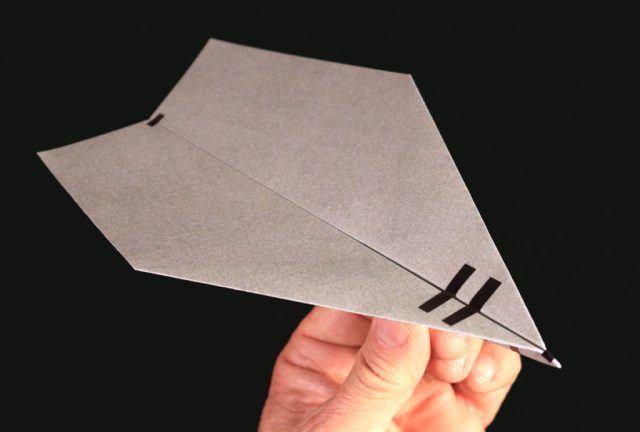All great planes used to be named after great women. My nod to that tradition was naming my world-record paper airplane design after my wife.
Suzanne represents a number of firsts. It’s the first glider to hold the record for distance, thrown by Joe Ayoob in 2012. It’s the first time a thrower/designer team has held the record. (Predictably, the old world record holder hated the idea, but Guinness liked it.) It’s also the first paper airplane to use a variable dihedral angle to optimize lift-to-drag over a range of speeds.
There’s still a $1,000 reward to use my plane to break the Guinness World Record for distance. We know the plane goes well beyond the current record of 226 feet 10 inches; Joe has thrown the plane more than 240 feet.
We hope you’ll build and fly the Suzanne glider. We’d love to know just how far the plane can go.
Glider or Dart?


Previous record holders were very small-winged darts. The wings were more like the fins on an arrow; simply for directional stability and not providing lift. It didn’t matter if the plane rolled, which they frequently do. The throw was a simple 45° launch, like any ballistic projectile.
For that reason, those kinds of planes were called ballistic darts (Figure B). The old record holder, a ballistic dart, took only 3 seconds to go 207′ 4″.
My plane is a glider (Figure A). It takes 9 seconds to fly 226′ 10″. My plane gets launched level, climbs on its own by generating lift, and really flies the last third of the flight. It gently touches down and skids to a stop. The old kind of plane simply crashes into the finish line.
Fold Your World Record Paper Plane
The folding is easy (throwing for a world record is not), but the taping will take some time. All folds are “valley” folds ( — — — — ) except for the “mountain” fold ( — •• — •• ) in Step 9. This tutorial is excerpted from my book The World Record Paper Airplane and International Award-Winning Designs which you can find at thepaperairplaneguy.com/shop.
1. Make a diagonal fold. Line up the top with the left side.
2. Unfold Step 1.
3. Make a diagonal fold the other way.
4. Unfold Step 3.
5. Line up the left edge with the diagonal crease.
6. Line up the right edge with the other diagonal crease.
7. Fold the top down, across the point where the diagonal creases cross.
8. Fold the top corners down to meet at the centerline. The top layer creases should line up with the bottom layer. Follow the existing creases.
9. Fold the plane in half. The mountain fold means you flip it over first, then fold in half.
10. Rotate the plane ¼ turn so that the center crease is on the bottom.
11. Make the wing fold. Start by positioning the creased edge of the wing against the center crease, but don’t fold yet. Keep pulling the wing down until the little white triangle is gone. Now fold. Then make the other wing match.
12. Cut the tape into strips 30mm long: 3 strips about 2.25mm wide, and 7 narrow strips about 1.5mm wide.
13. Apply tape strips in the numbered order shown here. Note that strips 3, 4, 5, 15, and 16 are wider strips. Strips 3, 4, and 5 are all cut from one wide strip. Strips 10, 11, and 12 are all cut from one narrow strip.


14. Use your dihedral gauges to set the angle at the nose at 165°, and at mid-wing 155°.
Going the Distance

looks on.
To throw your world record plane, hold it where the most layers meet (at the thickest part). Keep the wings level. Strive for smooth acceleration.
Get the plane flying straight, and then work up to a fast throw. For turns at regular gliding speeds, you’ll adjust the trailing edge of the plane normally. See “The Flight Stuff” below for tips on adjusting your plane’s control surfaces.
But keep in mind that the faster this plane flies, the closer to the nose your adjustments will be made. At our highest throwing speeds, if the plane veered right on launch, I would bend the leading edge on the left down a little, at the nose.
$1,000 Reward!
Use this design and officially break the world record for distance, and a $1,000 reward is yours. You must be named by Guinness as the world record holder.
John Collins teaches the Bluprint class “Plane Games: Make & Fly Paper Airplanes” where he shows how to fold and fly five of his best designs, including this world-record plane, and tests each one for distance, speed, and more.























